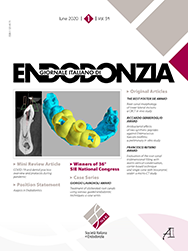Original Articles
Vol. 34 No. 1 (2020)
Use of dynamic navigation for a minimal invasive finding of root canals: a technical note
Publisher's note
All claims expressed in this article are solely those of the authors and do not necessarily represent those of their affiliated organizations, or those of the publisher, the editors and the reviewers. Any product that may be evaluated in this article or claim that may be made by its manufacturer is not guaranteed or endorsed by the publisher.
All claims expressed in this article are solely those of the authors and do not necessarily represent those of their affiliated organizations, or those of the publisher, the editors and the reviewers. Any product that may be evaluated in this article or claim that may be made by its manufacturer is not guaranteed or endorsed by the publisher.
Received: 11 November 2019
Accepted: 28 January 2020
Accepted: 28 January 2020
851
Views
469
Downloads











